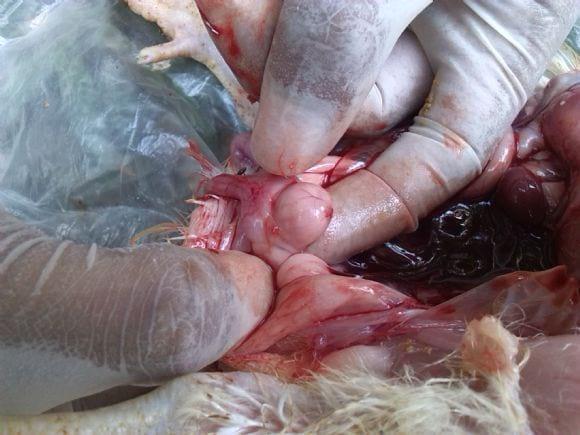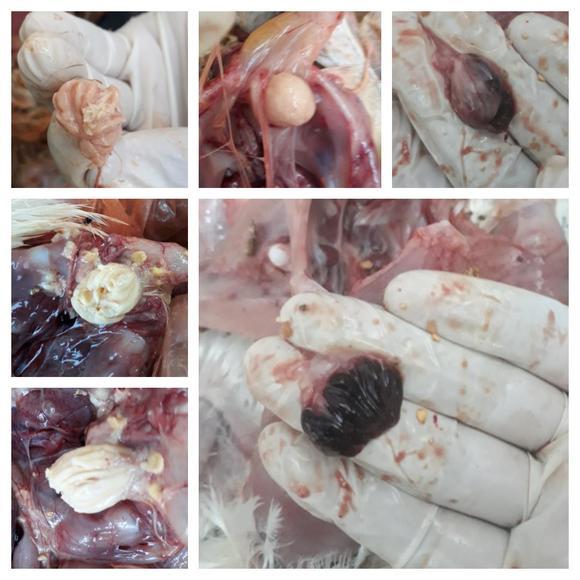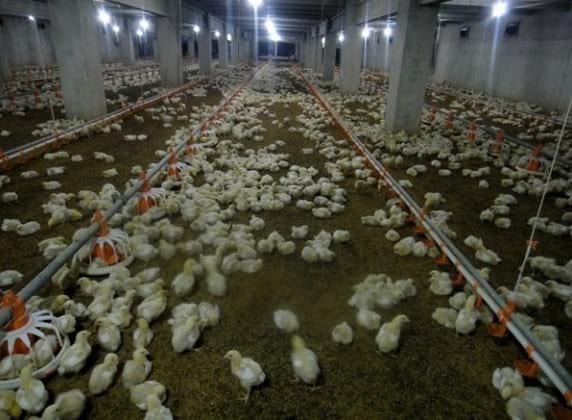Explore all the information on
Gumboro
Infectious bursal disease is seen in young domestic chickens worldwide and is caused by infectious bursal disease virus (IBDV). Clinical signs include listlessness, watery diarrhea, ruffled feathers, and dehydration. Morbidity rate is high and mortality rate is usually low, but some virulent strains cause mortality rates of 60% or higher. Macroscopic and microscopic lesions in the cloacal bursa and molecular identification of the viral genome are used for diagnosis. Vectored and attenuated live virus vaccines can be used to induce active immunity in chicks as the maternal antibodies wane. Infectious bursal disease is an economically important viral disease of young domestic chickens worldwide. Infectious bursal disease was first identified in Gumboro, Delaware, in 1962. Infectious bursal disease affects young domestic chickens worldwide. Classical strains predominated until the emergence of variant IBDV strains in 1986.
Back ground One of the challenges I had during my work as the research and development manager of one of the leading semi-integrated (rearing/processing) broiler operations in Sri Lanka was to investigate why infectious bursal disease (IBD) out breaks occurred from time to time in the two close house broiler farms belonging to the company despites of administering three IBD vaccines during a production cycle. It was...
Comments : 3
Recommendations: 1
Introduction
Gumboro Disease, more properly called Infectious Bursal Disease (IBD), is one of the most important viral diseases of chickens. The virus responsible for this condition (IBDV) can be found in almost all farms and countries.
Many studies have already been conducted on this disease but more are still needed to better understand the consequences of...
Comments : 78
Recommendations: 3
17 days old broiler bird infected with IBD, Characterized by Swollen bursa and hemorrhage on thigh and breast muscle....
Comments : 0
Recommendations: 0
Dear members, I would like to know your opinion about the use of recombinant vaccines to prevent ILT, Newcastle disease and Marek´s Disease in chickens. What are the advantages and disadvantages in comparison with Conventional Poultry Vaccines? Look forward to hearing your experiences! ...
Comments : 7
Recommendations: 0
I would be grateful if somebody could tell me what is the effect of high antibody titer of Gumboro in broiler breeders. Will the egg or its quality be affected? What is the impact of that high antibody titer on the progeny? ...
Comments : 3
Recommendations: 0
Karel Schat (Cornell University) talked about Marek's Disease and Infectious Bursal Disease when discussing this subject, during IPPE 2020 in Atlanta, USA....
Comments : 1
Recommendations: 1
Picture showing lymphocidic effect (lymph follicles of bursa of fabricius) Lesions undergo various stages of serious haemorrhagic to severe haemorrhagic inflammation. In the picture also shown that, bursa filled with coagulated fibrinous exudates and formed casts with the shape of mucosal folds ...
Comments : 5
Recommendations: 1
Dr. Sjaak de Wit,immunologist and poultry veterinarian at GD Deventer, The Netherlands, speaks about Infectious Bursal Disease (IBD) at the International AMEVEA seminar in Peru, 2013. ...
Comments : 3
Recommendations: 1
Introduction: Modern egg production sometimes imposes stressful breeding conditions for animals. Sensorial pleasure allows the release some neuro-hormones like dopamine or endorphins which have anti-stress properties (ESCH, 2004). Birds were traditionally thought to have a very poor sense of smell, but since 1999 confirmed in 2004, the chicken genome sequence has revealed a number of olfactive receptor genes comparable to humans (STEIGER, 2008)....
Comments : 0
Recommendations: 1
INTRODUCTION
Infectious bursal disease virus (IBDV) is a major cause of economic losses in the poultry and can be involved in mortality, immunosuppression and poor technical performance without clear clinical signs. However, these signs are not specific to IBDV. Therefore, diagnostic tools are needed to identify IBDV infections in relation to a clinical or subclinical problem in the field....
Comments : 3
Recommendations: 0
INTRODUCTION The bursa of Fabricius (BF) is a lymphoid organ, of lympho-epithelial structure. It is a site of B lymphocyte repertoire differentiation and maturation, located in the dorsal terminal part of the cloacae of the birds (Toivanen, et al 1987; Alloui & Sellaoui 2012). The BF is the essential (primary) target of Gumboro disease virus (IBDV). This disease manifests as acute and subclinical forms in chicks of age 0-3 weeks with immunosuppression or also in...
Comments : 0
Recommendations: 0
Gumboro is an acute, highly contagious viral infection in chickens manifested by inflammation and subsequent atrophy of the bursa of Fabricius, various degrees of nephritis and immunosuppression. Clinically the disease is seen only in chickens older than 3 weeks.
The period of clinical symptoms and high death rate is at the age of 3 - 6 weeks.Gumboro also called infectious bursal disease( IBD) could, however, be observed as long as chickens have a functioning bursa. In chickens...
Comments : 11
Recommendations: 1
Background The poultry industry provides the principal source of animal protein in many developed and developing countries [1]. The adaptability of poultry production systems has fuelled expansion of the industry to most areas of the world with high productivity and relatively low costs. However, intensive systems and backyard flocks remain threatened by viral, bacterial and...
Comments : 1
Recommendations: 0
Gumboro Disease or Infectious Bursal Disease (IBD) is one of the most common diseases of commercial poultry in Asia. In the clinical acute form (vvIBDV), the disease causes significant economic losses due to mortality, reduced performance and immunosupression that lead to increased susceptibility to other diseases. The IBD virus is extremely resistant to environmental conditions and chemicals. Therefore the control of the disease must take into consideration strict biosecurity combined with...
Comments : 18
Recommendations: 1
.jpg&w=3840&q=75)

Srinivasa Farms and Hy-Line: Pioneering Growth in India’s Poultry Market
Suggested link
A doctoral thesis, directed in IRTA-CReSA, proves that highly virulent IBDV comes from Asia. The doctoral thesis dissertation of Jennifer S. Toskano Hurtado explained this investigation. The thesis was entitled “Caracterización genómica y epidemiología molecular del virus de la Bursitis infecciosa en España” (Genomic characterization and molecular epidemiology of infectious bursal disease virus in Spain) and was directed by Natalia Majó and Jose...
Comments : 4
Recommendations: 0
1. Introduction Infectious Bursal Disease (IBD) serotype 1 viruses continue to cause direct and indirect significant economic losses to poultry industry. The direct economic impact of IBDV is due to the high mortality rates [1, 2]. The indirect economic impacts is due to IBDV-induced immunosuppression of infected birds [3], Infectious bursal disease viruses are non-enveloped, icosahydral...
Comments : 2
Recommendations: 0
In my experience, during the rearing period of layer flock, most farmers faced problems with IBD and ND (resp.form/visceral form) at 20 to 30 days of age. Sometimes along with coccidiosis or colibacillosis. Mortality varies from 20 to 30%. Lost uniformity, less feed intake ,due to lake of knowledge, debeaking was done with less body weight. Lately, the flock performance was not satisfactory. Could veterinarians please help me with any...
Comments : 0
Recommendations: 0
INTRODUCTION Poultry and poultry products are essential sources of protein supplement to humanity. The poultry population in Nigeria has been estimated to be 104.3 million, comprising of 72.4 million chickens, 11.8 million ducks, 4.7 million guinea fowls, 15.2 million pigeons, and 0.2 millions turkeys (FDLPC, 1992., Ajala et al, 2007). The main source of animal protein in Nigeria includes beef, chicken,...
Comments : 0
Recommendations: 0
Introduction Infectious bursal disease, also known as Gumboro disease, has caused great economic losses in the poultry industry in different parts of the world due to mortality and immunosuppression. It is a contagious acute viral disease of young birds. The disease may be clinical with variable mortality, and subclinical without mortality. The clinical form of the disease occurs in birds from the third week of age and...
Comments : 9
Recommendations: 0















_1.jpg&w=3840&q=75)


.jpg&w=3840&q=75)



.jpg&w=3840&q=75)


















